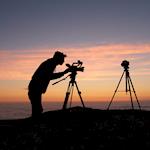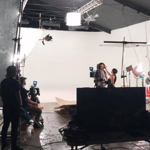The program’s numerous short films created with Blackmagic Design’s URSA Mini Pro and DaVinci Resolve Studio
Located in Pleasantville, NY, the Jacob Burns Film Center (JBFC) developed its Creative Culture fellowship program to help champion underrepresented voices and diverse storytelling. Now in its fourth year, Creative Culture has helped 35 filmmakers create projects that have been selected by top tier film festivals, such as Sundance, Berlinale, and SXSW, and acquired by Fox Searchlight, POV, NY Times Op Docs, and Staff Pick’d at Vimeo. This includes recent projects such as Adam Meeks’ “Union County” which premiered at this year’s Berlinale, and Crystal Kayiza’s “See You Next Time” which was selected at Sundance 2020 and recently acquired by The New Yorker.

According to Creative Culture Director Sean Weiner, “When selecting film projects, we look for stories that are underrepresented or not yet told. That is, of course, an incredibly subjective thing. There is an expansive history of films and filmmakers that many of us do not know frankly because those films and filmmakers were never introduced or celebrated in our circles. With Creative Culture, we try to do our part to expand the breadth of stories celebrated in film by supporting and infusing narratives into the industry that are more representative of the people in this country. By selecting these film projects, we inevitably champion an inclusive group of filmmakers hailing from across the country and around the world.”
While Creative Culture’s projects range from documentary to narrative and from live action to animation, many do have one thing in common: they use tools from Blackmagic Design to bring their stories to life.
Creating a Collaborative Culture
Founded on a guiding philosophy of inclusion and collaboration, Creative Culture includes a Fellowship Program, a 10-month long experience for emerging filmmakers looking to produce two short film projects in a collaborative community; a Residency Program, four-to-six-week long intensive experiences for established filmmakers looking to work on a feature film project; and Creative Culture Network, an online hub of support for filmmakers far and wide.

Sean explains, “In 2016, the Jacob Burns Film Center recognized a gap in support for professional filmmakers at both the short and feature film levels. Before then, we had only supported one filmmaker at a time in making a short film. At the end of their experience, each filmmaker would share that, while they were grateful for the support, the program could benefit from a creative community of peers working on their own film projects. We listened to that feedback and launched Creative Culture as a collaborative community, putting emerging filmmakers together in real space to engage with, respond to, and uplift each other’s projects.
“In building the community, we saw a unique opportunity to contribute in our own small way to changing the film industry by empowering a more inclusive and collaborative community of filmmakers, expanding who gets the opportunity to tell the stories in this field.”
Several of Creative Culture’s recent projects were shot with Blackmagic Design’s URSA Mini Pro cameras and/or graded with DaVinci Resolve Studio.
“¡Chaporazzi!”

From Director and DP César Martínez, “¡Chaporazzi!” covers El Chapo’s Brooklyn trial from outside the courtroom through media spectacles, sidewalk conversations and selfies. Recently acquired by POV Shorts, the documentary screened at Big Sky Documentary Film Festival and is currently available on PBS.
According to César, “I wanted to make a film that challenges how we represent Mexico from the perspective of the United States. The ‘bandido’ character has long been a staple of American renditions of Mexicans and Latinxs. From old western films to shows like ‘Narcos,’ this ‘evil’ and ‘foreign’ adversary has both captivated and repulsed US audiences since the dawn of the 20th century. Those fictional renditions creep into the way our policies and perceptions of Mexicans unfold in real life. El Chapo, both as an actual criminal and a larger-than-life character, reveals our desire to perpetuate this possibility, so that we, as Americans, can continue to justify the treatment we execute on those ‘different’ from us. His trial provided the perfect opportunity to tell that story and continue that legacy. ¡Chaporazzi! sought to chronicle how that narrative is built and how we can learn to dismantle it.”
Since the URSA Mini Pro is a professional digital film camera that combines high-end film quality with the features and controls of a traditional broadcast camera, César was able to rely on its design to blend in with news reporters covering El Chapo’s trail.

“With the URSA Mini Pro, I could blend in seamlessly amongst the throngs of broadcast cameras outside of the Brooklyn Federal Courthouse. This allowed me to gain access into the world of my characters, as my presentative identity was more akin to an organized newscaster than an inquisitive, and often critical, documentary filmmaker. Without the URSA Mini Pro, I wouldn’t have been able to integrate myself into the world of the journalists building and perpetuating the myth of El Chapo,” explains César.
He continues, “I was able to shoot conversations between reporters and sightseers without them really thinking that it was anything other than b-roll for some nightly news broadcast. I was able to film the action of a press scrum without seeming like an outsider. I had the opportunity to tell a story about the process of storytelling while blending in with those around me. The URSA Mini Pro was a part of my outfit and helped keep me undetectable.”
“Nevertheless, the benefits of shooting with the URSA Mini Pro went beyond the costume of the camera. The beautiful 4.6K images produced by this camera allowed me flexibility in what I wanted to frame, considering the potential to punch into moments that may have been further than the reach of my lens. The detailing and dynamic range of the URSA Mini Pro granted ¡Chaporazzi! a sharp and filmic expression to carry the narrative through.”
César partnered with Colorist Justin Drobinski in post. “I was using the URSA Mini Pro to film observational footage of people and press action outside of the courthouse, an interview with a courtroom artist, and a print run at the New York Post printing facilities. Each location and scene provided different lighting and color scenarios, but the URSA Mini Pro was versatile and always delivered beautiful, clean images that were only further enlivened using DaVinci Resolve Studio,” adds César.
“DaVinci Resolve Studio helped color this world, imitating the flashy attitudes of ‘chaporazzis’ and their tabloids,” he concludes. “I collaborated with Justin to create a bright and punchy color palette that would resemble the hues of tabloids and newspapers covering the trial. DaVinci Resolve Studio helped us saturate specific colors to render a world where the dramatized fanfare of the trial lived inside the reds, blues and greys of a New York conquered by El Chapo.”
“Yves & Variation”
“Yves & Variation” is a documentary from Brooklyn-based Director Lydia Cornett that was selected for DOC NYC and Aspen ShortsFest, along with other festivals. It follows a New York City doorman who wears many hats as he works tirelessly to give back to his community in Haiti.
According to Lydia, ”Yves & Variation” is an observational portrait of Yves, an individual whose life is split between many roles: concierge, violinist, father, art dealer, and philanthropist. He also divides his time between bustling New York City and a coastal town in Haiti. Shot by DP Kervin Marseille, “Yves & Variation” was filmed on three different cameras in two very different locations: New York City and Haiti.
“The cinematography is gorgeous, but the footage had many of the issues familiar to documentary production: found lighting, mixed lighting sources, inconsistent exposure and white balance, and mixed camera color profiles. So, color correcting and grading in DaVinci Resolve Studio was about smoothing over these inconsistencies to create a cohesive visual style that felt natural and supported the observational filmmaking without drawing too much attention to itself,” explains Colorist Justin Drobinski. “The Haiti footage was shot with one camera, whereas the NYC footage was shot with an URSA Mini Pro. That camera shift, combined with the completely different characteristics of the locations (all the lush greens in Haiti, for example), meant that the most work was done with the Haiti footage, to match it more closely to the NYC footage.”
“I knew I needed a camera that could function in run-and-gun settings while still capturing high quality, cinematic images,” notes Lydia. “I also wanted to use a color correction program with a toolset that could account for the variety of shooting locations in the film.”
Kervin adds, “The URSA Mini Pro’s 15 stops of dynamic range provided us with an insane amount of play in post. It was a huge workflow advantage because we were able to take the native files from the camera directly into DaVinci Resolve Studio. It was a very flawless transition.
Justin relied on DaVinci Resolve Studio’s waveform tools to help evaluate overall exposure and color balance, while using the parade and histogram features to fine-tune specific color balances. “For example, the lobby of the apartment building where Yves works had a lot of green or purple color spikes, and DaVinci Resolve Studio’s scopes and white balance picker helped me find a satisfying balance. I was able to shift the lobby shots from an unpleasant green or purple to a much warmer picture,” he says. “Additionally, the qualifier and windows tools helped me isolate specific problem areas, such as overexposure or a particular color that didn’t fit in the palette of a scene or sequence. For example, the scene where Yves travels by boat in Haiti had a very broad exposure that didn’t match many other shots in the sequence, and the orange of his life preserver glowed nuclear. The qualifier tool was especially helpful there.”
“DaVinci Resolve Studio’s tracker made it incredibly simple to move the windows within a shot – I never had to worry about subject or camera movement. Additionally, saving stills in the gallery allowed me to easily copy-and-paste looks or specific nodes between shots, as well as easily compare shots side-by-side. This was especially helpful when evaluating the greens and browns in the Haiti footage, such as when Yves travels around visiting various artists,” Justin concludes. “In many ways, ‘Yves & Variation’ felt like a familiar documentary grade. The mixed cameras and locations emphasized the differences in each shoot. But the toolset in DaVinci Resolve Studio made it very easy to compare shots throughout the entire piece and smooth everything into a cohesive whole.”
“The Couple Next Door”
“The Couple Next Door” is a recent narrative short from Director Abbesi Akhamie, a Nigerian-American writer/director and producer based in New York City. The film features lush cinematography and music from West Africa, making the entire piece a cultural exchange that explores morality when it comes to love, marriage and friendship.
According to Abbesi, “The story follows a woman whose feelings of loneliness begin to stir when an eccentric immigrant African couple moves in next door. We filmed inside a small apartment building in Brooklyn, which enhanced the intimate atmosphere in regard to camera placement and production design. This is fully realized at the end of the film when the protagonist sits alone in her small kitchen. The camera was placed closer to her and she was framed with a longer lens. We see the intricate patterns of the African print she wears against her skin under a sultry warm low light creating a moment that is quietly provocative.”
Shot entirely with an URSA Mini Pro by DP Kristin Kouke, Abbesi recalls, “I wanted a camera that allowed me to push my style in a new and creative way. My inspirations were ‘In the Mood for Love’ by Wong Kar Wai and ‘Mother of George’ by Andrew Dosunmu. In both films, colors and tighter spaces were prevalent, and I was able to replicate this in my own film with the support of the URSA Mini Pro using Zeiss Supreme lenses.”
With Colorist Justin Drobinski using DaVinci Resolve Studio, Abbesi describes the film’s workflow between production and post. “When shooting with the URSA Mini Pro, the camera preserves color and detail that can be expounded upon when color correcting in DaVinci Resolve Studio. It was wonderful to imagine the visuals in my mind and then to craft them with the camera and color grading software. It allowed me to bring forth intimacy, work well in low light, and then bring out colors and contrast in DaVinci Resolve Studio. The duo supports the film's native vibrancy, while the story itself creates new discussions for audiences.”
“Blackheads”

“Blackheads” is a stop-motion and 2D animated short film about a woman coping with bad therapy, heartbreak and blackheads. Told through a dreamy, winding narrative of autobiographical fiction, “Blackheads” follows the young woman through a morning spent recounting–and attempting to internally reconcile–heartbreak. It was directed by Emily Ann Hoffman, whose films have screened at SXSW, Sundance, Slamdance and more.
“‘Blackheads’ was supposed to be an intimate portrait of a woman confronting her inner demons and outer pimples,” explains Emily. “I wanted the film to feel visceral, but simultaneously warm and welcoming. My favorite part of working with miniature stop motion sets is lighting them to look like ‘real life.’ The first step was working with the talented DP Russell Peborde to achieve this in production, and then with Eun-ah Lee, the colorist, in post. We looked at Wes Anderson's stop motion productions to reference the warmth and vibrancy of the color he achieved in ‘Fantastic Mr. Fox’ and certain moments in ‘Isle of Dogs.’ Eun-ah's work in DaVinci Resolve Studio was critical to cleaning up the color to give us our final curated look.”
Blending the two distinct styles of stop motion and hand-drawn animation, Emily and Eun-ah relied on DaVinci Resolve Studio to create a cohesive look. “Our character's facial features were hand-drawn in Photoshop and then overlaid on the stop motion characters in our VFX software. Before color correction, there was a stark contrast between the two styles. One of my favorite things Eun-ah did was finesse these features – softening the outlines and warming the tones so that they blended with the skin a bit more, while still maintaining their integrity as two different animation styles.
“See You Next Time”
Providing a window into the intimate moments shared across a nail salon table between a Chinese nail artist and her black client in Brooklyn, “See You Next Time” is a new short from Director Crystal Kayiza, whose last film “Edgecombe” screened at Sundance and won the Gold Plaque at the Chicago International Film Festival.
“The nail salon is a very visually rich space. More than any specific reference, there was a lot of language that was at the forefront of my mind that we worked to convey,” explains Crystal. “We tried to approach the structure of the film like a performance and wanted all aspects of the design, including the color, to inform the discourse in the film. I wanted the tone and texture of the image to match the opulence and beauty of nail art. We wanted to create a consistency across the two worlds presented in the film, one that allowed all bodies and movements to feel immersed in operatic feel of the film.”
For that, Colorist Natacha Ikoli used DaVinci Resolve Studio. According to Natacha, “Early on my conversations with Crystal involved paying attention to skin tones and making sure the mixed light in the salon could be controlled so it would feel like they belong to the same world. Overall, we wanted it to be a warm environment without being yellow. DaVinci Resolve Studio’s HSL tool was extremely useful to accurately select the hues that needed special attention. The cinematographer had shot the footage with a lot of intentions already in terms of color and contrast. I used DaVinci Resolve Studio’s curve tool extensively as this piece was all about channeling the right amount of richness and contrast.”
“Union County”
Having premiered at this year’s Berlinale, “Union County” follows a young man in rural Ohio as he navigates a drug court recovery program and the return of his ex-girlfriend. The film was directed by Brooklyn-based filmmaker Adam Meeks and color graded by Matt Greenberg of Irving Harvey.
According to Adam, “Fundamentally and broadly speaking, we were interested in a certain stark naturalism as specifically as we could achieve it. The film blends documentary and scripted footage, professional and non-professional actors, utilizes exclusively natural light, and was filmed with an intentional lack of control. With all of that in mind, the precision with which Matt was able to control and dial-in the nuances and details of natural spaces in post, thanks to DaVinci Resolve Studio, was profoundly valuable and important.”
“Our goal for ‘Union County’ was to emphasize the natural beauty of the locations and thoughtful cinematography with a subtle touch and a careful attention to time-of-day,” adds Matt. “As such, my work focused on primary grades using the primaries’ wheels and curves. DaVinci Resolve Studio's intuitive controls allowed me to keep things looking natural while emphasizing the time-of-day in each scene and bridge any gaps due to changes in natural light.”
Matt also relied on DaVinci Resolve Studio’s temporal noise reduction feature and OFX Glow tool throughout the film. “The OFX Glow tool is one of my favorite relatively recent features added to DaVinci Resolve Studio. For our scene in the courthouse, I used it to help with bright highlights, gently softening roll-off and helping with the impression of brightness without losing excessive detail,” explains Matt. “The temporal noise reduction feature was crucial in helping clean up some of the lower light scenes, such as the dusk car scene early in the film.”
Matt concludes, “At the end of the day, without DaVinci Resolve Studio's flexible and intuitive color grading and comprehensive feature set, I don't think it would have been possible to achieve the look we found for ‘Union County.’”
About Creative Culture
Creative Culture remains committed to its guiding philosophy of inclusion and collaboration. The true testament of this program’s value is in its reputation as a community where filmmakers care deeply about one another’s projects and, more importantly, about one another. ― Director of Creative Culture, Sean Weiner.
Jacob Burns Film Center developed Creative Culture to champion diverse voices and foster a thriving artistic community from the region, across the country and around the world. Donor-funded fellowships and residencies help to ensure that people from every economic background have access to this rich experience.












Comments
There are no comments on this blog post.